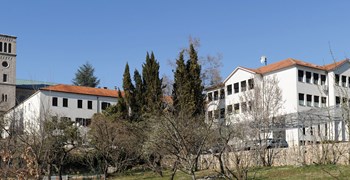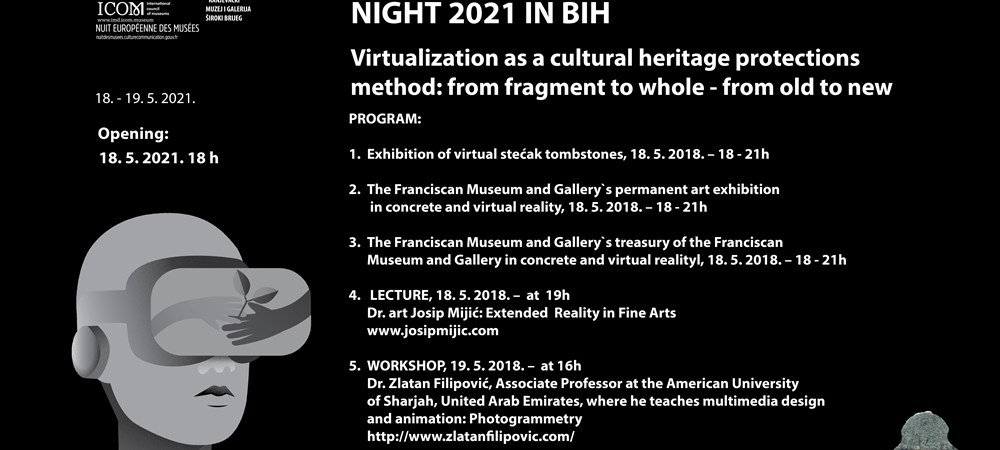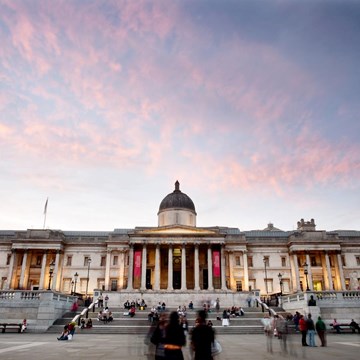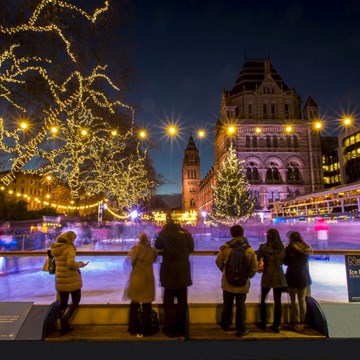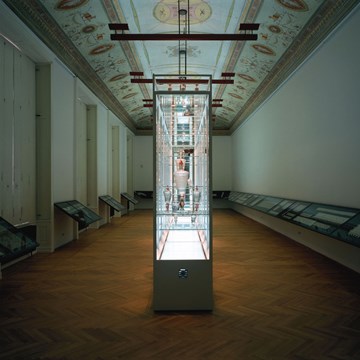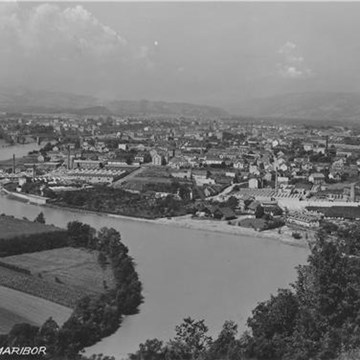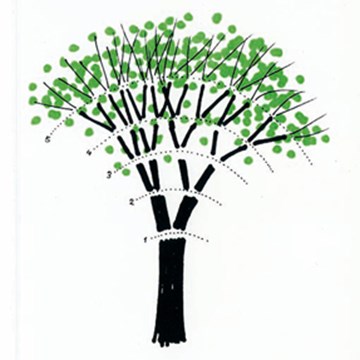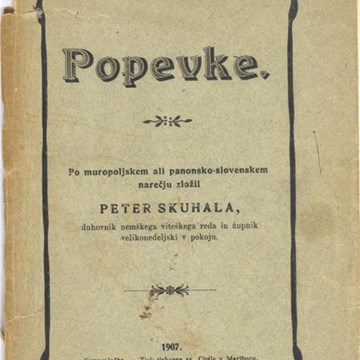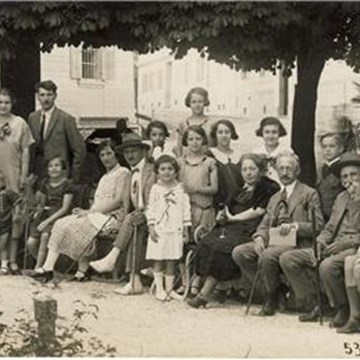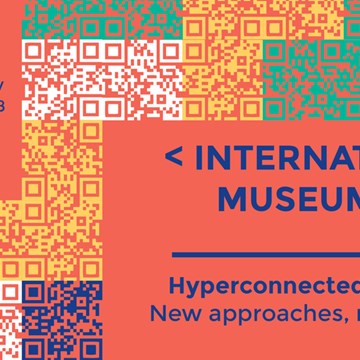Virtualization as a cultural heritage protections method: from fragment to whole - from old to new - International Museum Day and European Museum Night / Virtualizacija kao metoda zaštite kulturne baštine: od fragmenta k cjelini – od starog k novom
The Museum of Široki Brijeg and the Franciscan Gallery programme
for the International Day and European Museum Night 2021 in BiH
The Future of Museums: Recover and Reimagine
May 18 - 19, 2021
Project organizer: Franciscan Museum and Gallery Široki Brijeg
Project author: Josip Mijić
Project Curator: Danijela Ucović
Exhibitors: Zlatan Filipović, Josip Mijić, Ana Naletilić
Lecturers: Zlatan Filipović, Josip Mijić
- Exhibition of virtual stećak tombston
Zlatan Filipović
- Locality name: Necropolis Kopošići, next to the Catholic cemetery - near the settlement Nasići - the medieval city of Dubrovnik
GPS coordinates: 44.00427649139194, 18.345115722053976
https://skfb.ly/onVs8
Program: Reality Capture
- Locality: Očevlje, next to the old Orthodox cemetery - Breza municipality - the area of the medieval city of Dubrovnik
GPS coordinates: 43.99000493018718, 18.3150074700723
https://skfb.ly/onVsM
Program: Reality Capture
- Locality: Maculje necropolis - Rostovo locality - listed in the UNESCO`s world heritage list
GPS coordinates: 44.05032434816845, 17.67508403599633
https://skfb.ly/onVsW
Program: Reality Capture
Josip Mijić
- Name of the site: Dislocated stećak tombstones near the Blessed Virgin Mary church in Posušje, that were transferred from Tribistovo village, the Piškovića strana site, and the village of Zagorje - the Slavić site
GPS coordinates: 43.4763408, 17.327697
https://skfb.ly/onOMu
Programmes: Meshroom, Blender
- Locality: At Dilić
GPS koordinate: 43.12434802301963, 17.589622751508454
https://skfb.ly/onQWM
Programmes: Meshroom, Blender - Locality: Ričina (the left side of the cemetery watched from the main road to the north and the stećak tombstones in the Roman Catholic cemetery)
GPS koordinate: 43.483590, 17.300299
https://skfb.ly/onRKA
Programmes: Meshroom, Blender
Ana Naletilić
- Locality: Dislocated stećak tombstones near the BVM church in Posušje that were transferred from the village of Tribistovo - the Piškovića strana site and the village of Zagorje - the Slavić site
GPS coordinates: 43.4763408, 17.327697
https://skfb.ly/onQGv
Programmes: Meshroom, Blender
- Locality: Mokro, replica of Vitko's stećak, the original is in front of the National Museum in Sarajevo) GPS coordinates: 43.36339249745984, 17.580287096209478
https://skfb.ly/onTHL
Programmes: Meshroom, Blender - Locality: Beneath the Sekulana
GPS coordinates: 43.14011905924326, 17.58023616197576
https://skfb.ly/onUSr
Programmes: Meshroom, Blender
2. The Franciscan Museum and Gallery`s permanent art exhibition in concrete and virtual reality
About the permanent art exhibition:
The Franciscan Gallery`s permanent art exhibition was opened on October 6, 2015, and it consists of 230 works and covers the period from the middle of the 19th century until 2015. It was edited by art historian and writer Igor Zidić from Zagreb, in cooperation with dr.art Josip Mijić and Fr. Vendelin Karačić. 203 authors are represented, mostly from the Republic of Croatia and Bosnia and Herzegovina. The exhibition also includes works by all professors and lecturers from the Academy of Fine Arts in Široki Brijeg.
Permanent art exhibition in virtual reality:
On the occasion of the Croatian Museum Night 2020, the permanent art exhibition of the Franciscan Museum and Gallery Široki Brijeg was scanned and uploaded to Matterport with the help of a three-dimensional camera system for creating an immersive three-dimensional experience: https://my.matterport.com/show/?m= onw4qABemft. This novelty is an integral part of the Art Permanent Exhibition.
- The Franciscan Museum and Gallery`s treasury of the Franciscan Museum and Gallery in concrete and virtual realityl
About the Treasury:
The Treasury exhibits old masters paintings from the 16th to the 19th century, chalices and other ritual, mostly metal objects dating from the beginning of the 17th to the 20th century, and the church vestments from the end of the 18th and from the 19th and the beginning of the 20th century. , as well as old book. The most valuableone is the Incunabula from 1493. The treasury was temporarily placed on the ground floor of the gallery, as part of the Permanent Art Exhibition.
Virtual reality treasury:
On the occasion of the Croatian Museum Night 2020, the Treasury of the Franciscan Museum and Gallery Široki Brijeg was scanned and uploaded to Matterport with the help of Matterport, a three-dimensional camera system for creating an immersive three-dimensional experience: https://my.matterport.com/show/?m=kwcsY6yozrs. This novelty is an integral part of the Treasury.
iz 1493. Riznica je privremeno postavljena u prizemlju galerije, u sklopu Stalnog likovnog postava.
- LECTURE
Dr. art Josip Mijić: Extended Reality in Fine Arts
www.josipmijic.com
- WORKSHOP
Zlatan Filipović, Associate Professor at the American University of Sharjah, United Arab Emirates, where he teaches multimedia design and animation: Photogrammetry
http://www.zlatanfilipovic.com/
Virtualization as a cultural heritage protections method: from fragment to whole - from old to new
For the fifth time, the Franciscan Museum and Gallery Široki Brijeg is participating in the International Museum Day and European Museum Night, with the theme The Future of Museums: Recovery and Rethinking, organized by the International Council for Museums (ICOM).
This year, the Franciscan Museum and Gallery`s employees have chosen to use modern information technologies to display extremely important fragments of historical heritage, culture and art - stećak tombstones - and thus give the opportunity to analyze and get to know the stećak tombstones from the area of Herzegovina and the coast, which are categorized as national monuments, but also the world`s heritage monuments. The photographs of the stećak tombstones were transformed into three-dimensional shapes via the Meshroom and Reality capture photogrammetric programs, which were virtually placed in the gallery with the help of the Arloop app. Nine stećak tombstones, from the Pišković, Slavić, Dilić, Ričina, Mokro, Rostovo, Beneath Sekulana, Koposici, Ocevlje and Maculje sites, will come to life in the Franciscan Gallery in Široki Brijeg as educational content intended to encourage visitors to investigate, inform themselves and to entertain as well.
The reasons of putting the stećak tombstones in the main focus of this important international cultural event are numerous. Stećak tombstones are considered to be medieval stone tombstones that appeared in the period between the 12th and 16th centuries on the territory of the medieval Bosnian state and its border areas, so today they are mostly found in Bosnia and Herzegovina and less in Croatia, Serbia and Montenegro. There are about 70,000 stećak tombstones in BiH, and it is assumed that there were many more. However, the most attention attracted on the stećak tombstones is the uniqueness and authenticity, which in a special way testifies the creative and civilizational continuity of the cultural circle on these areas. When it comes to understanding stećak tombstones, one can often respond to the set theses with the antitheses, because there is a whole range of aspects that are not clearly grounded. The mystery of this sepulchral heritage has intrigued experts and alike from the 18th century to the present day. The incomplete clarity of this cultural phenomenon in Bosnia and Herzegovina preoccupies history and culture lovers, which is why they could often be viewed from the several analytical positions.
Scientists and researchers have not yet determined with certainty how the stećak tombstones were delivered from the stone pits to the locations where they were placed, because even today, with the help of modern technologies, it is not easy to move individual stećak tombstones, and some of them weigh more than 30 tons. The age of these tombstones was determined with the help of inscriptions on them - epitaphs, but if we consider the fact that only about 400 stećak tombstones have these inscriptions on them, the question about the relevance of the sample and its application on all stećak tombstones could be asked. They have no inscriptions. There are only few archaeological excavations in the necropolises of stećak tombstones poor so it still isn`t possible to determine with certainty the creative continuity of stone monuments in all necropolises. Unfortunately, the archival medieval documents in the region did not provide a valuable insight into the meaning and production of stećak tombstones, which is why the period of the ending of their mass production, was not precisely determined. In addition, it is not yet known whether there were stonemason workshops that produced them and whether our ancestors possibly had some stylistic guidelines to be applied on the stećak that was the product of the creative inspiration and ability of a craftsman or artist. Also, we do not fully know who and what were the people whose culture of life and death was marked by such imposing stone monuments. It is not entirely clear whether only wealthier people were buried under them or whether the stećak tombstones were accessible to everyone as a sign of eternity in some area. The turbulent history of these areas has contributed to the fact that it is not possible to know exactly how many of them were destroyed, relocated or still hidden somewhere (archaeological research was conducted only below those in situ)
Their modern, accepted and most commonly used name - stećci - is not unique because they are also called bilig, kam, zlamen, house, eternal home, masete, mramorje, planter, and necropolises are popularly called Roman, Greek, Turkish, Hungarian, Divsko and Chifut cemeteries.
The fact that the stećak tombstones were theexpression of a collective creative, spiritual and mind impulse is evidenced by their extremely rich typological diversity, so that in the simplest division they appear in the forms of blocks, chests, gables, crosses, pillars and amorphous monuments. However, the most intriguing are the wide range of motifs that can be found on them, as well as the various stylistic expressions with which they were depicted, including: deer, lion, horse, dog, bird, snakes, and dragons. Fantasy and other animals, tools, hammer, chisel, status symbols, stick, book, cup, weapon, swords, shields, maces, cross (crux comissa, crux ansata, crux gemmata, anthropomorphic and stylized cross, tau cross with rosette, etc. .), crescent, star, circle and circular wreath, crescent, lily, spirals, vegetabilia, wheel, hunting, people and others. Although it is not always entirely clear whether these symbols - around whose interpretations many analytical constructions are placed - were used as decorative ornaments, religious, astral or cultic symbolism in the period of their origin, in modern times they gain the power of description and narration and speak more about life than death. All the mentioned features point to the fact that stećak tombstones are still an elusive and unexplored stone treasure that will, through modern and scientific interdisciplinary methods, hopefully further clarify the complex and multi-layered way of life in the territory where they are widely located.
The stećak tombstones, or more precisely the 20 necropolises from BiH, became a UNESCO World Heritage Site in 2016. Books and scientific papers about them are permanently published, new assumptions are made, but also facts are established. Scientific gatherings and workshops are held, and sometimes they are used as tools for modern ideological outwitting. As a unique value from the past, they are involved in the present, which is mostly reflected in the search of individuals for the original, ancient identity. However, the knowledge and insights of the general public about the importance of stećak tombstones are not great. The best evidence of this is the numerous necropolises that are not adequately protected from either natural or human factors,
There is a great fear among the experts that the certain stećak tombstones will decay, and they are afraid of their unauthorized removal as well. A stronger commitment to educating young people through the education system, informing and animating all age groups through cultural and scientific events, as well as creative tourism offers, can certainly contribute to better preserving and analyzing these witnesses of the indigenous past that can be a way to understand the present. That is why the Franciscan Museum and Gallery Široki Brijeg in the event International Museum Day and European Museum Night with a new, digital exhibition practice intends to present a small part of the local past and thus unite distant time forces, combine different technologies of human creativity, permeate different ways of life and to unite them all at one place as well.
Danijela Ucović
International Museum Council (ICOM) ˗ International Museum Day (MDM) i
European Museum Night
The future of museums: recovery and redesign
According to the International Council on Museums (ICOM) study from the May 2020, about 95% of all museums worldwide were closed due to the global pandemic caused by the COVID-19 virus. Considering the global economic consequences of the pandemic and the wider social context, the multiple, direct or indirect impact of the pandemic of each gallery or museum institution is evident.
The decline in the number of new coronavirus infections in 2020 has allowed museum institutions in Europe’s largest cultural centers - Paris, London and Rome - to open their doors to visitors in early summer. With the re-growth of the number of infected, museums were closed again in the autumn, when new measures were introduced, regardless of the earlier application of epidemiological measures (masks, distance).
Museum and gallery institutions reacted in different ways to the crisis that unexpectedly hit the whole world and all segments of activity. Some institutions quickly found different and interactive solutions and opportunities to protect them from closure: they focused on creating new and expanding existing digital databases, but they also became active on social media. On the other hand, a large number of museums and galleries needed time to find a suitable action model, which is why they urgently postponed annual plans and programs, stopped the commercial strategy or stopped working completely. Due to weakened tourism, but also due to caution, the number of visitors has decreased significantly, which leads to problems with income and adequate protection of objects, and the existence and development of culture, education and art depends on the economic development of a society. The method most often resorted to by states in times of crisis is to reduce the funding allocated to arts and entertainment firstly, and the consequences of this are not negligible. That is the reason why the museums and galleries around the world are facing the biggest challenge today, because a successful way out of the crisis - in line with modernity and new digital achievements - means a change in the paradigm of the functioning of museum institutions The foresight, knowledge, ability and creativity of museum and gallery staff is a capacity that we believe will further strengthen institutions of this character and return them enriched to their visitors.
Considering this, it is important to point out to the fact that many museums and galleries have accepted this pandemic crisis as a situation in which they need to provide more comprehensive and stimulating content to the public. In addition, the new conditions have led to a re-examination of the technical reach of individual institutions, as well as their confrontation with the challenges of displaying a collective fund or art works in a time of accelerated technological change. Therefore, it turned out that some of the key tools for survival are different digital potentials and virtual expertly guided tours, as well as virtual independent tours, because they give the visitor space and time freedom, the possibility of more detailed analysis, and they are currently free. However, such a museum sustainability opens up a space for debate over whether museums will have to commercialize the online experiences offered. An aggravating circumstance for the complete success of virtual tours may be the need and habit of visitors to see and directly experience a work of art or museum object. Visitors should undoubtedly be afforded a strong experience and experience of the original work of art, because without this magic, copies and reproductions could replace museum and gallery settings around the world. Also, museum and gallery staff should know how to preserve art as a sublime result of human creativity and by interacting in reality to preserve authentic humanity in relation to hybrid humanit
Digital and virtual museum and gallery reality - as a new and ubiquitous dimension of curatorial practices - except as an element to overcome the crisis in these institutions, can contribute to a stronger implementation of art and cultural heritage among people of all ages and interests. Accessibility of works and objects is a priority, and digital platforms have already provided mechanisms for reaching different groups of people, some of which were previously neglected. Transforming the gallery experience provides additional information, emphasizes creativity and expands insight into material culture and art, which is equally important in normal and crisis and present and future times. In this way, museums will be more strongly positioned as key protagonists of local development and as incomparable places to meet and learn. In addition, digital and virtual capabilities can play an important role in maintaining the local economy and the social fabric of communities and peoples in the long run. Therefore, the aim of the International Museum Day (MDM) and the European Museum Night is to raise awareness of the fact that: museums are an important means of cultural exchange, enrichment of cultures and development of mutual understanding, cooperation and peace among nations.
Danijela Ucović
Exhibitions and events
We don't have anything to show you here.
Activities from this museum
We don't have anything to show you here.
